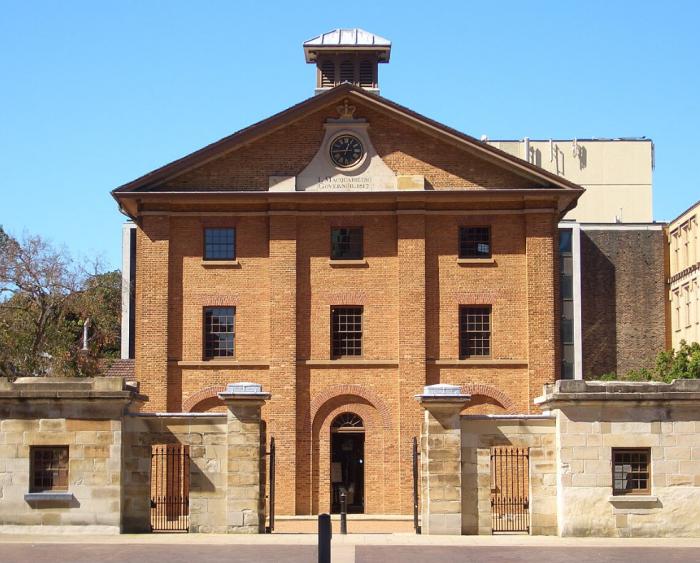Hyde Park Barracks |

Hyde Park Barracks in Sydney is a place of outstanding importance for all Australians.
It is one of the most significant secular buildings surviving from Australias colonial era.
As the first convict barrack in the colony, it marked a major change in the living and working conditions of male convicts in New South Wales.
It is also major evidence of Governor Macquaries vision for Sydney and one of the finest works of the accomplished colonial architect, Francis Greenway, who was himself a convict.
Before 1819 there was no government accommodation for convicts. Instead, convicts secured lodging and fire in private houses and hotels in areas like The Rocks. They were permitted to work privately after their days work for the government in order to pay for this.
In The Rocks public houses howe'ver, convict men and women and soldiers associated freely after working hours. They shared a love of town life and, in many cases, personal networks from the old country. Further, disorderly public behaviour and frequent robberies in The Rocks led to increasing demands for greater control of convicts living arrangements.
Male Convict Barracks
1819 - 1848
In response, Governor Macquarie ordered the convict architect Francis Greenway to design a building where convicts could be secured at night. Convict artisans and labourers began work under Greenways supervision in 1817 and the Barracks was completed in 1819.
It provided basic housing for 600 male convicts, the labour force Macquarie needed for his ambitious if sometimes unauthorised public works program.
For almost 30 years, up to 1,400 convicts assembled here nightly. Convict boys were lodged in a separate ward from the men until 1820 when the Carters Barracks was built on the southern outskirts of the town. The boys were then moved to this new lodging.
In addition the the permanent lodgers, a stream of other convicts were brought to Hyde Park Barracks for trial, punishment and reassignment from the surrounding areas.
On Sundays the convicts washed, shaved and dressed in clean linen before attending Divine Service. They were mustered and inspected by the superintendent before being accompanied to church by overseers.
The church still stands in Queen Square today. It was constructed by convict labour to Francis Greenways design.
The Barracks lodged both government-employed convicts and convicts assigned to work for private masters. Although the men were referred to as prisoners, it was not a prison.
Nevertheless, the Barracks was part of a strategy to restrict convicts freedom and raise their productivity. They were given basic accommodation and increased rations of food but lost opportunities for private earnings and were still forced to work long hours for the government.
Shortly after its opening, Francis Greenway observed that the Barracks routines and rations had promoted an unenthusiastic and institutionalised workforce.
A sentence of flogging was handed down for offences against discipline in the Barracks - drunkenness, gambling, disobedience, neglect of work, absconding or desertion, abusive language, insubordination or disorderly conduct.
After 1830, a Court of General Sessions established at Hyde Park Barracks administered punishments for Barracks men and other government-employed convicts. Penalties included days in solitary confinement, iron gangs, walking on the treadmill at Carters Barracks or a maximum of 150 lashes.
The court could also extend convicts sentences by up to three years with hard labour and transfer men to penal settlements in the colony or as far away as Norfolk Island and Port Arthur.
By 1833 floggings took place in a yard behind the Barracks rear wall. In response to colonial and British concerns about brutality, the maximum number of lashes ordered by a single magistrate was then limited to 50. In 1833 a new regulation lash was designed by Superintendent Slade.
Convict transportation to New South Wales officially ceased in 1840. In 1848 the men remaining at the Barracks were sent to the penal establishment at Cockatoo Island and the building was adapted as an immigration depot to accommodate unprotected female assisted immigrants.
Female Infirm, Destitute Asylum
1862 - 1886
To remedy a domestic labour shortage and gender imbalance in the colony, many single or orphaned young women were encouraged to emigrate from Britain and famine-racked Ireland by the opportunities for employment in the growing colony.
The arrival of 200 orphan girls on the Earl Grey launched the buildings new role as a reception and labour exchange for unprotected female Assisted Immigrants.
These young women resided in the lime washed brick dormitories from their arrival until their services were hired out. In 1848 the Barrack was especially adapted to accommodate them and it fulfilled this role from 1848 to 1886.
The women were supervised by a matron and they resided in the Barracks until hiring day when colonists engaged them as domestic servants.
The thousands of women who passed through the depot were subject to a strict regimen of domestic duties, moral management and religious instruction. The women were confined for their own protection and ministered to by clergy.
In the early 1850s the Immigration Depot also housed the wives and children of convicts brought to the colony at government expense to be reunited with their husbands and fathers.
In 1862 the government established Hyde Park Asylum on level 3. It was not a lunatic asylum but a refuge for infirm, destitute women who had no relatives to support them. As well as elderly women, there were many young women in their twenties and thirties who were physically disabled.
Terminal patients from the nearby Sydney Infirmary sheltered in the overcrowded asylum with the other social outcasts. As their numbers increased, the asylum gradually took over most of level 2.
The asylum was completely segregated from the Immigration Depot and had its own entrance and fenced recreation yard. The only paid servant was the head laundress. Able-bodied inmates were expected to clean, cook and assist in the laundry.
The women were renowned for their sewing and mending skills and made most of the clothes worn in the asylum. Sewing and repairing clothes and bed linen helped with the economy of the institution.
At times occupants complained about unwholesome and decrepit conditions. Rats were active in the wards; their nests yielded a unique archaeological collection when excavated one hundred years later. Other artifacts fell between the floorboards or were hidden there by women for safekeeping; and examples of these are now on display in the museum.
In 1886 the inmates were transferred to the newly built Newington Asylum near Auburn.
Courts and Government Offices
1887 - 1979
Accommodation for government departments, which had appropriated the perimeter buildings from 1848, sprawled through the courtyards until eventually a string of courts and government offices were established in the dilapidated dormitories vacated by the women.
Partitions, new joinery, windows, doors, stairs, wall and ceiling finishes transformed these spaces into offices for various branches of the Attorney Generals Department, which remained there until 1979.
Courts occupied rooms in the northern perimeter building from 1830. In the prosperous 1880s new social policies created legal specialisations which spawned departments of registrars, clerks and typists.
In the first two decades of the 20th century, Federation and the separation of State and Commonwealth powers meant statute books had to be progressively rewritten. The Barracks saw much of this activity. Offices were adapted and jostled for space and superiority.
Rooms were subdivided and spruced up as outbuildings expanded. Two large corrugated iron courtrooms were attached to the rear of the main Barracks building, which was also connected by overhead bridges to the bustling northern complex.
The southern range, occupied variously by the Immigration Depot and the Volunteer Rifle Corps, was altered in 1887 for the City Coroner and demolished by 1909 to make way for the Registrar Generals building.
Industrial issues dominated government business through the early 20th century. With the creation of the Australian arbitration system, Queens Square courts became a focus for the struggle for workplace reform in New South Wales.
Landmark decisions handed down here include the basic living wage in 1927 and equal pay for women under State awards, rejected when heard in 1921 but granted in 1973.
Museum
1984 - Today
Happily, Hyde Park Barracks was narrowly escaped demolition a number of times over the last century.
The first proposal that the Barracks become a museum was made in 1935. Other proposals followed. In 1975 a decision was made to retain the Barracks complex and by 1979 conservation and museum adaptation works were planned by a team of architects, historians, archaeologists and museologists.
Reconstruction work was carried out by the Public Works Department from 1980 to 1984.
The Museum of Applied Arts and Sciences then set up the Barracks as a museum of social history.
In 1990 the Historic Houses Trust assumed control of the Barracks and refurbished it as a museum about its own history.
The Australian Monument to the Great Irish Famine is a sculptural installation by Hossein and Angela Valamanesh entitled An Gorta Mar (The Great Hunger).
It symbolises the experiences of young Irish women fleeing the Great Irish Famine of 1845 to 1848. The project was initiated by the Great Famine Commemoration Committee and the first stone was laid by the President of Ireland, Mary McAleese, during her state visit to Australia in September 1998.
The monument was launched on 28 August 1999 by the then Governor-General of Australia, Sir William Deane.
The Barracks Museum is still open today and well worth a visit the next time you are in Sydney.
❊ Address ❊
⊜ Macquarie Street Sydney 2000 View Map
℅ Gadigal
❊ More Information ❊
→
en.wikipedia.org
➼ www.eurekacouncil.com.au
➼ Wikipedia, the free encyclopedia
❊ Also See.. ❊
➼ Hyde Park | Sydney
➼ Hyde Park Barracks Museum
Update Page








